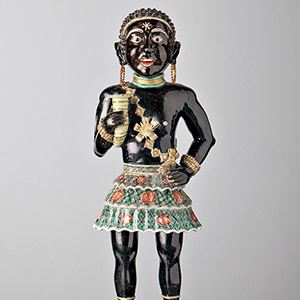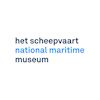
09. Noord 0, Republic at Sea: Chinese Famille Noire
Why don’t you pause your audio player for a moment and take a good look at this exceptional sculpture in detail. What exactly are we looking at here...? This porcelain figure of an African man was commissioned by a European and made in China. This figurine reveals all kinds of European and Chinese assumptions about people from unfamiliar cultures. The red lips, wide eyes and scanty clothing are racist depictions commonly used in Europe and Asia to represent people of African origin. The golden earrings and the ‘slave collar’, as it is known, around the neck are unmistakable references to the European slave trade. The figure also has clear Chinese characteristics that reference Buddha, such as the hairstyle, the extended earlobes and the lotus leaf he is standing on. The star on his forehead can be seen as Buddha’s third eye, but it is also a reference to the African continent. The combination of European and Asian forms and ideas is typical of the art made for export in China at that time. To us, the statuette represents the exchange of ideas and visual imagery, as well as the stereotypical views and preconceptions of other cultures that were in circulation at that time. Three hundred years later, these themes remain current and still give us food for thought.


The National Maritime Museum
Het Scheepvaartmuseum (The National Maritime Museum) shows the strong connection between the maritime world and society as a whole, and more specifically the impact of this on the lives of many individuals. The collection of The National Maritime Museum is one of the largest and most notable maritime collections in the world with approximately 400,000 objects, including paintings, models of ships, navigation instruments, and maps of the world. Discover 500 years of Dutch Maritime history as well as its strong links to today’s society and the society of the future.
- Kattenburgerplein 1
- Amsterdam Netherlands
- (020) 52 32 222
- www.hetscheepvaartmuseum.nl
